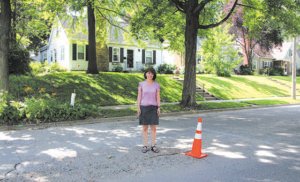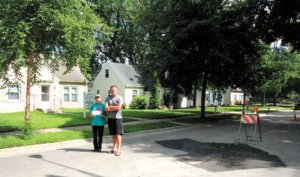 Some homeowners south of Lake Nokomis are leaving the neighborhood, and others worried about paying high project bills
Some homeowners south of Lake Nokomis are leaving the neighborhood, and others worried about paying high project bills
By TESHA M. CHRISTENSEN
$18,500.
That’s how much Andrea and Dave Vogeo are paying to repair their water line.
The Vogeos have been living in their home on 16th Ave. S. between Edgewater and E. 57th St. since 1976, and are both retired. They are in their 70s, and live off Andrea’s Social Security check. On June 24, 2019, they began dealing with a water break, having trouble washing dishes, doing laundry, taking showers, and more. The break wasn’t fixed for a month.
“It’s frustrating,” Vogeo said.
They have also been dealing with a tree limb that came down in a storm.
“It was a bad week,” she stated.
When the Vogeo’s line broke, they peered into the hole and saw chunks of asphalt inside, pieces that should have been removed with the repair to their neighbor’s break the year before. They suspect that the rubble left in the hole contributed to their line break, and they think that the city or prior repair company should be covering the cost of this fix.
The Vogeos are just the latest in a long line of issues that have occurred along this stretch of street since 2015.
In all, there have been nine sewer line breaks, one water line break, and too many sinkholes to count.
A domino effect
The issues on 16th between Edgewater and 57th St. Started in 2015 with a resurfacing project. When they ended for the day, workers left the machines parked at the north end of the street. They started to sink within a few hours, recalled Joan Soholt, who lives along the street. A manhole and two utility laterals to homes were damaged, and it took about six weeks to repair them.
Soholt recalls getting a letter from the city that the utility lines had been checked before the street work, and they were all found to be in good working order.
Since then, eight homes built around 1940 have dealt with utility line breaks. The area in the middle of the block has been the worst, with four houses dealing with the hassle of sewer and water line breaks – and the associated bills that are getting higher and higher with each project as fewer companies bid on them.
When Soholt’s line broke in 2015, she had a $4,500 bill.
The city received only one bid for the Vogeo project. At $18,500 it’s three times higher than what the Swansons paid last year.
“No one would take the bid because no one wants to work in our area,” observed Soholt. “They know the headache of this street.”
She added, “The contractors said that no other company wants to bid on the Nokomis area because it is not easy with the groundwater and higher water table, and they have plenty of other opportunities for jobs in easier locations citywide. They have to put extra workers on the job and bring in extra equipment which escalates the price even if the job does not require pumping.”
Plus, these bills are coming on the heels of the resurfacing assessments each homeowner paid in 2015 that ranged from $2,000-$2,400.
 Why isn’t the city dealing with water issues?
Why isn’t the city dealing with water issues?
Erik and Monica Swansons moved from Michigan to South Minneapolis six years ago, and have loved the area. They thought they’d found their long-term house when they bought their bungalow along 16th. But they've decided to move out and have put their house up for sale – leaving behind a sewer line in good condition for the new owners.
They’re not the only ones leaving. So are the residents across the street who are dealing with their second utility line break in the past few years, observed Soholt.
“What makes this worse is the city’s incompetence,” E. Swanson said.
Their sewer line detached in March 2018, but it took three months for them to receive a letter from the city about the project because of misinformation on the address from the city which prolonged the repairs. At one point Erik called, and was told that his line was fine.
He eventually got a letter with information on the three companies that had bid on his project. The lowest bid by InnerCity was $5,200 – a bill the Swansons were responsible for paying.
In Minneapolis, homeowners are responsible for paying for water and sewer line repairs from the connection in the middle of the street and for the wye connection to the sewer main, according to an ordinance change in February 1992. There is nothing that holds the city accountable to make sure the main is in good condition before repairs are made, pointed out Soholt.
“Most cities will pay for the line up to the meter in the house,” observed Swanson. Additionally, in Minneapolis, residents are officially required to maintain the line from the middle of the street into their homes.
“How do you maintain something that is nine feet under the ground?” Swanson asked. “I don’t get it. If it is in the house, you can maintain it. We can’t monitor what’s underground.” Swanson pointed out that every utility bill he receives from the city lists a maintenance fee, and he questions what that is for.
Homeowners can opt to pay the entire cost at the end of the project, or put it on their property tax bill and pay a 5% interest fee each year on the balance. Some residents can qualify for deferments, but interest continues to accumulate on the total amount and must be paid when a property is sold. The city bids the project out. Homeowners can solicit bids themselves, but then they can’t attach it to their tax bill and have to pay it off themselves right away.
The Swansons had just bought a cabin, and paying for that and a utility repair bill stretched their budget too far. Six months after the first repair, the line required additional work. Luckily that was warrantied by the repair company who fixed it at no charge.
Swanson said he’d be less angry about this if he didn’t pay so much in taxes, a bill that last year was about $6,000. “I don’t mind paying taxes, but I want something out of it,” he said.
Vogeo agrees. She’s frustrated that the city is using millions of taxpayer money to create bike paths but not repairing its streets and utility lines.
What’s with the sinkholes?
The issues on her street spurred Soholt to take action, and she began asking questions trying to figure out what was happening. Her street isn’t the only one on the southwest side of Lake Nokomis that is dealing with sinkholes and utility line breaks.
“Edgewater is like the Grand Canyon,” Swanson observed. A football field length of pavement has been repeatedly repaired due to sinkholes west of 16th.
One day, emergency vehicles were called because a sinkhole developed and caused a break to a gas line on park land south of the lake.
Soholt’s search for answers has led her to question why the water table in the area is rising. She learned about homes near Solomon Park just south of her where residents have lost half of their backyards to standing water and dealt with sewer back-ups in their basements. She’s spoken with people at Hope Lutheran Church (5728 Cedar Ave.) who are dealing with an elevator that has rusted because of standing water.
She questions the volume of water coming down Minnehaha Creek, and how the weir is used at Lake Nokomis. She noticed that when the culvert under Highway 62 from Mother Lake was closed last year for repair, the lake level dropped. It rose again right after the culvert draining water from Richfield into South Minneapolis was re-opened.
Together with other concerned citizens, she formed the Nokomis/Hiawatha Water Sustainability group, which is tracking water issues in the area and advocating for comprehensive water studies.
“We’re the epicenter,” said Soholt.
“We are aware that increased precipitation is the cause of the problems. What we are questioning are current water management practices in light of the forecasted changes. How can communities upstream equitably manage their own water runoff locally without sending it all downstream where it is adversely affecting other communities?”
~ tesha@longfellownokomismessenger.com
Comments
No comments on this item Please log in to comment by clicking here